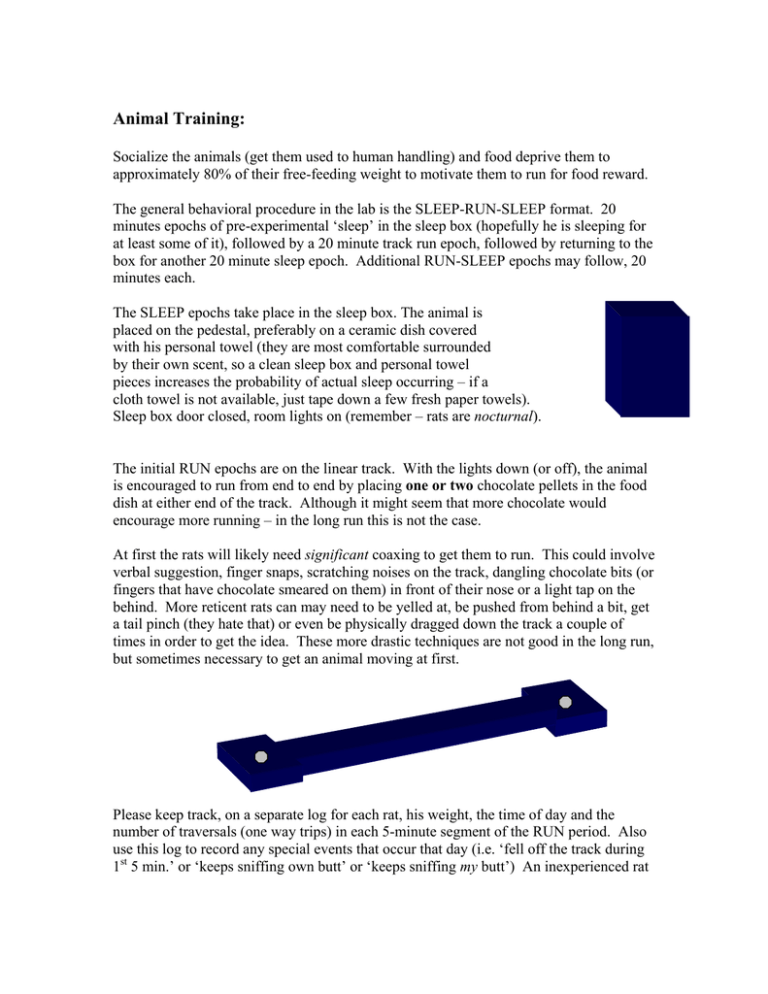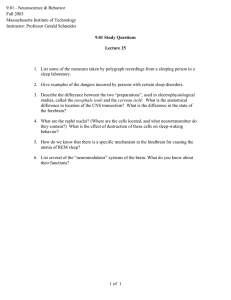Animal Training:
advertisement

Animal Training: Socialize the animals (get them used to human handling) and food deprive them to approximately 80% of their free-feeding weight to motivate them to run for food reward. The general behavioral procedure in the lab is the SLEEP-RUN-SLEEP format. 20 minutes epochs of pre-experimental ‘sleep’ in the sleep box (hopefully he is sleeping for at least some of it), followed by a 20 minute track run epoch, followed by returning to the box for another 20 minute sleep epoch. Additional RUN-SLEEP epochs may follow, 20 minutes each. The SLEEP epochs take place in the sleep box. The animal is placed on the pedestal, preferably on a ceramic dish covered with his personal towel (they are most comfortable surrounded by their own scent, so a clean sleep box and personal towel pieces increases the probability of actual sleep occurring – if a cloth towel is not available, just tape down a few fresh paper towels). Sleep box door closed, room lights on (remember – rats are nocturnal). The initial RUN epochs are on the linear track. With the lights down (or off), the animal is encouraged to run from end to end by placing one or two chocolate pellets in the food dish at either end of the track. Although it might seem that more chocolate would encourage more running – in the long run this is not the case. At first the rats will likely need significant coaxing to get them to run. This could involve verbal suggestion, finger snaps, scratching noises on the track, dangling chocolate bits (or fingers that have chocolate smeared on them) in front of their nose or a light tap on the behind. More reticent rats can may need to be yelled at, be pushed from behind a bit, get a tail pinch (they hate that) or even be physically dragged down the track a couple of times in order to get the idea. These more drastic techniques are not good in the long run, but sometimes necessary to get an animal moving at first. Please keep track, on a separate log for each rat, his weight, the time of day and the number of traversals (one way trips) in each 5-minute segment of the RUN period. Also use this log to record any special events that occur that day (i.e. ‘fell off the track during 1st 5 min.’ or ‘keeps sniffing own butt’ or ‘keeps sniffing my butt’) An inexperienced rat may only make 5 or 10 traversals in any 5 minute segment. A well trained rat can easily top 50. Rats are exploratory animals, and will sniff around a new environment or a new handler. They also tend to groom themselves when nervous or uncomfortable. After a rat has been trained to run, it is best to try stop these behaviors when they occur, or at least limit them to only a couple of seconds at a time. Light prodding or sharp noises generally do the trick. If a rat is constantly picking at the track itself, or the food dishes, that probably means its time to change the dish or the contact paper on the track. A typical experiment will be SLEEP-RUN-SLEEP-RUN-SLEEP, 20 minute epochs. (The place field generation/modification experiments are SLEEP-RUN-SLEEP-RUNSLEEP-RUN-SLEEP.) After a few days of preparatory training, try to get the animals used to this schedule. Two animals can be trained simultaneously, as one will be in the sleep box while the other is on the track. Daily training works best for task acquisition. Weekly training (or biweekly, for more complicated tasks) is usually sufficient for decent behavior maintenance after an animal has begun to run well. Different researchers follow training regimens of different strictness. Best behavior is achieved when animals are run at the same time every day, under the same environmental conditions (noise, light, smells, visual cues, personnel in room, etc.) I prefer to have my animals used to a wide variety of environmental conditions so that they are more likely to run during the actual experiments, as things always seem to be in flux and a little bit unpredictable at that time (i.e. don’t worry about the lights or the time of day too much, as long as you get him to run).




